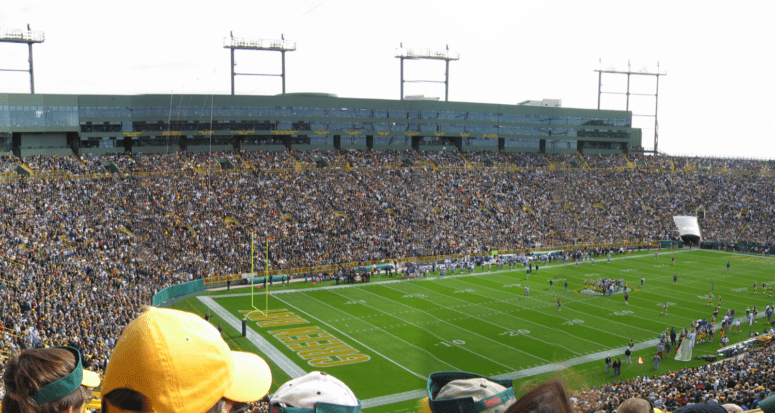How to Buy a House in Green Bay Without Dipping Into Your Artisanal Cheese Budget
- Published on
- 3 min read
-
 Emily Hines Contributing AuthorClose
Emily Hines Contributing AuthorClose Emily Hines Contributing Author
Emily Hines Contributing AuthorEmily Hines is a writer and content strategist with 8 years of professional experience focusing on architecture, travel, and culture and contributes to a variety of publications including USA Today, TimeOut, and Craftbeer.com. She holds a Masters in Historic Preservation from the University of Georgia and is currently based in Marquette, Michigan where she writes a monthly travel blog, drinks craft beer, and skis.
If you’re looking to live that lake life but enjoy some big-city amenities — yet without skyscrapers blocking your view and snarls of crazy traffic — then Green Bay, Wisconsin, is the place to call home.
With festivals year-round, Packers football, and outdoor adventure at your doorstep, Green Bay locals have lots to do to keep busy…but buying a house here does have its challenges. With a condo shortage, limited garages, and roofs that get beat up all winter long, finding the right house in Green Bay can be tricky.
But don’t worry! We’ve done the legwork for you, interviewing local agents and experts in Green Bay, gathering all the important information you need to make the best decision when buying a house in Green Bay.

First things first: What’s your budget?
The overall housing stock in Green Bay is almost an even split, with rentals taking up 41% of the market while owner occupied properties are at 52% (5.5% of the housing is vacant) as of 2020. Green Bay is an affordable place to buy; costs were approximately 20% lower than the national average in 2018, and the median home price was $146,358 in November 2019. Home appreciation went up 7.5% in 2019. And since the housing crash of 2008, Green Bay has rebounded and exceeded sales expectations.
Strong sales and demand a decade after the 2008 Great Recession low point has many in the business wondering what the new normal will look like. But with subdivision development increasing, the market doesn’t seem to be slowing down. If you’re on a tight budget, Green Bay is a great place to purchase because you can buy a home for under $200,000. If you have your heart set on a waterfront property on the Fox River however, it can cost upwards of $1 million.
Not sure what you can afford in Green Bay? Start by exploring HomeLight’s Affordability Calculator.
Timing is everything
Nothing affects the housing market in Green Bay like the weather. Spring and summer bring sellers out of hibernation, showing off lush, lush green yards, flowers, and the promise of longer days full of sunshine. Fall is equally busy thanks to that autumnal glow beaming all around, making you feel warm and cozy. (Or maybe that’s just the maple cinnamon latte from Kavarna Coffeehouse?) Bottom line, sellers are typically in control of the market during the spring, summer, and fall months.
But buyers can take full advantage of the winter months and get an amazing deal on their dream home. Think about it: it’s cold out, and there is snow and ice everywhere. Who would want to move in those conditions? That is exactly why you can get a great deal in Green Bay during the winter months.
Caleb Hayes is one of Green Bay’s top agents; according to his Team Leader, Karri Bedor, most “people selling their house during the winter usually need to sell their house. They’re much more willing to negotiate because they need to get rid of a property.”
Think of all the money you’ll have to add to your cheese budget after you save by buying a house in Green Bay!
Green Bay quirks
Even if you’ve purchased a home before, there are some issues specific to Green Bay, Wisconsin, that you’ll want to understand.
Located on Green Bay and with several rivers running through the city, flooding can be an issue and can cause major foundation problems. “Green Bay is literally split in half by the East River and experienced record flooding in Spring of 2019, exposing a number of foundation issues in this area,” Bedor recalls.
“If your home inspector in Green Bay comes across any potential foundation issue, they will likely recommend a specific foundation inspection right away.”
When looking at properties, you can visit the Inspection Division office to see if your property is located in one of the mapped Special Flood Hazard Areas. If it is, you can obtain handouts or talk with an inspector about protecting your property from flooding.
With an average of 50 inches of snow a year, roofs in Green Bay get beat up all winter long as the snow piles up for months. And it might not stop at 50 inches; 2019 was the snowiest winter to date in Green Bay, and all of that snow and ice creates hefty weight on a home’s roof, plus melting and freezing throughout the winter can also create ice dams in the gutters. You can request a separate roof inspection to determine the health of a home’s roof. If you’re into the mid-century modern look and interested in purchasing a ranch-style house with a flat roof, it is helpful to be vigilant with snow removal during the winter months. The lack of roof slope will cause the snow to remain for longer periods of time and possibly cause damage to the roof.
Don’t forget to have radon testing done on the home! Approximately 1 in 10 Wisconsin homes test positive for radon, and it is the second- leading cause of cancer in the United States. This radioactive gas occurs naturally in the ground and can infiltrate your home through cracks in floors or walls. Some home inspectors are certified for radon testing, or you can hire a radon removal expert to assess the home. The good news is you can test a home prior to purchasing and have a certified radon mitigation contractor fix the issue.

Getting around Green Bay
Green Bay proper
Like many mid-sized cities in the United States, Green Bay’s historic downtown is experiencing an urban renaissance. Empty-nesters and young professionals love living in downtown Green Bay because it is low-maintenance. Skip your commute to the office, forget about shoveling your driveway, and ditch your lawn service; life downtown is a breeze.
Caleb Hayes is one of Green Bay’s top agents; according to his team member, Karri Bedor, baby boomers are downsizing and flocking to condos downtown, so much so that there is a condo shortage in Green Bay.
“These buyers want to be able to fly south for the winter and not have to worry about taking care of their property while they’re gone,” Bedor explains.
Broadway District
Broadway District is one of the most popular neighborhoods downtown. Home to Wisconsin’s second-largest farmer’s market, restaurants, boutiques, and 40 annual events, you’ll never be bored in this neighborhood. Condominiums in this area range from the low $200,000s up to the mid $400,000s as of early 2020.
Astor Park
From the fur trade to the paper and shipping industries, Green Bay is full of history, and if you want to own a piece of that unique legacy, Astor Park is the place for you. The economic boom of the late 19th century and early 20th century saw an increase in fine Victorian architecture here. Nestled in between the Fox River and the East River, this neighborhood became a national historic district in 1980 and is full of manicured parks, stately streets lined with one-of-a-kind homes, and is just minutes from downtown Green Bay, making your commute a breeze. Prices range from $99,900 to $500,000 as of 2020, depending on the size and grandeur of homes.
De Pere and Ashwaubenon
If you need to make more room for your growing family or furry friends, think about purchasing a home in neighboring suburban neighborhoods like De Pere or Ashwaubenon.
Rated the No. 1 city in Wisconsin to live by AreaVibes, De Pere is just a 10-minute drive from downtown Green Bay or a 26-mile bike ride on the Fox River Trail and is a great place to purchase a family home. You’ll find one of the best public school systems in Wisconsin here and ample opportunities to get outside and play. De Pere has more than 400 acres of parks and green space, including outdoor swimming pools, two trail systems, and it’s only an hour or less from Lake Michigan.
Similar to De Pere, Ashwaubenon is a neighborly suburb of Green Bay. It’s ranked the No. 4 place to live in Brown County, with plenty of community parks and fun things to do thanks to the Titletown District and the Green Bay Packers’ Lambeau Field. Titletown is home to dozens of restaurants, shops, a night market, a playground — and in the winter, a skating rink, and tubing hill.
Homes in these villages are newer; in De Pere, more than 40% of the housing stock was built between 1970 and1999, and in Ashwaubenon about 39% of homes were built between 1970 and 1999, and single-story ranch-style homes are the norm. This means your home will have plenty of room for children and pets, or maybe you just need a lot of room to host Packers watch parties with your neighbors. Two car garages and large yards are easier to come by in these areas, but you’ll have to pay for it.
In De Pere you’ll find homes are priced higher, with a median home price at $167,000 as of 2019. While in Ashwaubenon, the median price is around $151,000. “We see bigger homes, bigger yards, and more two-car garages in the suburbs,” says Bedor. “Two-car garages weren’t part of the building trend in the ’50s and ’60s so you won’t typically find these in older homes on the market.”

Find a top buyer’s agent in Green Bay
With a competitive market and some unique idiosyncrasies, finding a knowledgeable real estate agent in Green Bay can help you navigate the market and potentially save you some cash. A top buyer’s agent in Green Bay can save you $22,173 on your sale — which, again, is a lot of cheese!
Whether you’re looking for stress-free living in a downtown condo or a family home with outdoor adventure at your doorstep, find a top agent to help you find your dream home in Green Bay, Wisconsin.
Header Image Source (re-sized): (Lordmontu / Wikimedia Commons via Creative Commons Legal Code)
